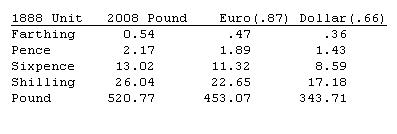For us souls forced to live elsewhere on earth. Dave
English currency system
Collapse
X
-
English currency system
We are all born cute as a button and dumb as rocks. We grow out of cute fast!Tags: None
-
Oh dear, I though you were posting a link to an interesting price comparison site.
Nice try though mucker, next time please find a page that compares purchasing power betwixt now and then. That would intrigue me.
Also, why the hell do modern books always refer to a shilling as being worth 5 pence?
Is it because both are a twentieth of a pound?
toodles
doris..."(this is my literary discovery and is copyright protected)"...

-
The site you want is on the anachronism thread. DaveWe are all born cute as a button and dumb as rocks. We grow out of cute fast!
Comment
-
"To expose [the Senator] is rather like performing acts of charity among the deserving poor; it needs to be done and it makes one feel good, but it does nothing to end the problem."
Comment
-
We are all born cute as a button and dumb as rocks. We grow out of cute fast!
Comment
-
Thanks Dave...nice work. DaveWe are all born cute as a button and dumb as rocks. We grow out of cute fast!
Comment
-
Iam terribly sorry proto, I sounded like a right grumpy bugger.Originally posted by protohistorian View PostThank You Supe for correcting for my failure to psychically intuit Doris's requirements. Dave
http://www.nationalarchives.gov.uk/currency/
If it is any defense I was as tight as an owl when I wrote my post.
I do appreciate your proffering of info, thanks.
And the other web site suggestions for fiscal comparisons were very interesting, although difficult to understand.
I think the main problem is that prices were so odd when one considers spending power of the average poor person.
Using the national archives site 4d equates to one modern pound. A pound for a place to stay the night, no matter how awful, seems remarkably inexpensive.
An interesting purchasing power fact that I happened upon of late is that in 1910 the average wage earner had to spend nearly 90 percent of their post rental money remnants on food alone!
Nowadays I believe the figure is nearer 15 percent.
SO I think the problem that I have, when considering 188 money and modern exchange rates is simply that the 2 sets of numbers are irreconcilable.
doris..."(this is my literary discovery and is copyright protected)"...

Comment
-
No worries Doris we all have those days. Yes, the numbers are irreconcilable to a degree. They are a very good example of an anachronism. Even the poorest of citizens in modern Europe or America, lives a standard of living higher than a medieval king. Much has changed, and from our vantage point we cannot fully realize life in say the 17th century. It is difficult and takes diligent study to get 1888 close to correct. Your apology is accepted, though unnecessary. Be well and keep up the study of the differences in culture then and now, it will pay off, I have confidence. Good Luck in improving your understanding. DaveWe are all born cute as a button and dumb as rocks. We grow out of cute fast!
Comment
-
-
Thank You both, very much. DaveWe are all born cute as a button and dumb as rocks. We grow out of cute fast!
Comment
-
Hello Doris,Originally posted by doris View Post
I think the main problem is that prices were so odd when one considers spending power of the average poor person.
Using the national archives site 4d equates to one modern pound. A pound for a place to stay the night, no matter how awful, seems remarkably inexpensive.
An interesting purchasing power fact that I happened upon of late is that in 1910 the average wage earner had to spend nearly 90 percent of their post rental money remnants on food alone!
Nowadays I believe the figure is nearer 15 percent.
SO I think the problem that I have, when considering 188 money and modern exchange rates is simply that the 2 sets of numbers are irreconcilable.
doris
If we accept this from the Old Bailey website:
The price of bread, the commodity most commonly used to measure historical change in the cost of living, reached its high point in the first half of the 1810s, when a four pound loaf of bread was priced at over a shilling. For most of the period on either side of the turn of the nineteenth century, the equivalent price was between five and ten pence for the same loaf.
So say 5d for a 4 Lb loaf of bread (~1814 grams).
About &2.27 now.
So estimating the purchase power of a Pence comes out to 45 Pence now.
A 4d bed = &1.80
Doesn't sound like much unless you have a 200 bed facility.
&360 per day. &10,800 per month without any of the insurances, utilities, service taxes, and what-not required or available today.
Some are said to have over 700 beds.
Sounds like a business to me.Dave McConniel
Comment
-
Nicely done Dave! DaveWe are all born cute as a button and dumb as rocks. We grow out of cute fast!
Comment








Comment